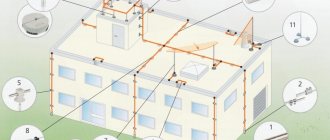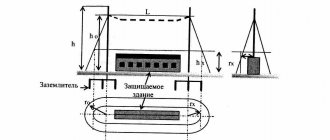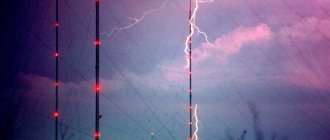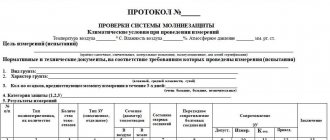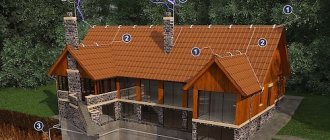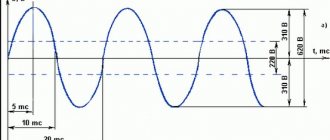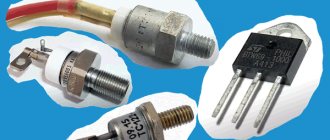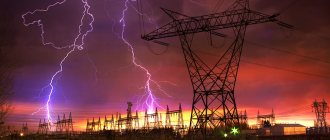The procedure for installing lightning drains (lightning protection) at industrial and civil facilities is regulated by a number of regulations and standards, starting with the PUE and ending with individual departmental instructions. All these documents contain requirements for lightning protection in terms of design (calculation), installation, commissioning and maintenance of these systems.
Parts of the structure
For a more precise understanding of the essence of the requirements, it should be taken into account that a typical lightning protection design consists of the following main parts:
lightning rod mounted at the highest point of the object;- a special tape conductor used as a connector of the discharge receiver with a grounding device (GD);
- the ground electrode itself, which ensures the discharge current flows into the ground.
Thus, each of the constituent elements of lightning protection performs its own, well-defined function that meets the requirements of current regulations, in particular PUE.
Normative base
The list of standards and regulatory documents that define the key points for the arrangement of lightning protection includes:
PUE (edition No. 7) “Lightning protection of buildings and structures”;- instruction RD 34.21.122-87 (Gosenergonadzor);
- instruction of the Ministry of Energy under number SO 153-34.21.122-2003;
- SNiP 3.05.06-85;
- a number of GOSTs and standards concerning the procedure for arranging lightning rods and grounding.
Paragraphs 4.2.133-4.2.142 of the PUE define the general principles of organizing lightning protection of electrical installations and the resulting overvoltages.
The requirements of these paragraphs apply to switchgear (switchgear) and transformer substations (transformer substations) of open and closed type, operating in power supply circuits, as well as other distribution and station electrical equipment.
Instruction RD 34.21.122-87 applies to the procedure for organizing lightning protection at designed civil and industrial facilities, taking into account their main functional purpose.
In addition, it classifies each of these buildings into a specific category, assigned depending on the danger of a lightning strike.
Another instruction (under the name SO 153-34.21.122-2003) concerns all types of buildings and structures, including industrial communication systems. It determines the procedure for taking into account lightning protection documentation during project development, construction, operation and reconstruction of all specified facilities.
And finally, the requirements of GOST (including the standards and rules in force in construction) apply to the procedure for arranging individual elements of lightning protection systems. Let's look at each of the documents listed above in more detail.
How does a passive lightning protection system work?
Without an installed lightning rod, the resulting lightning discharge will choose its own path to the ground. In this case, the chosen path will not be predictable; the conductor can be: telephone cable, electrical lines, water or gas pipes, or (in the case of reinforced walls) the building itself.
Under natural conditions, a lightning strike will follow one or more of these paths to ground, and may also pierce the "air cushion" (the principle of an electric arc between conductors), releasing energy and forming a flash to reach the most grounded conductor (with higher resistance).
As a result, lightning poses several dangers to any home or building:
1. Fire Hazard A fire can start anywhere where exposed contacts are near combustible materials (wood, paper, gas pipes, etc.) in a building, including structural wood or insulation inside walls and roofs. Bare contacts are formed after the discharge passes through the electrical wiring. Wires overheat and sometimes even vaporize, creating a fire hazard anywhere along the affected circuits.
2. Danger when breaking through the “air cushion”
By piercing the "cushion of air" between the conductors, the discharge can travel between rooms, possibly injuring anyone in its path, as well as igniting any flammable materials in its path. 3. Damage to building materials
The explosive shock wave created by a lightning discharge can destroy sections of walls, ceilings, windows and doors.
4. Damage to equipment
All equipment (TVs, microwave ovens, telephones, washing machines, lamps, etc.) connected to the network will be damaged and cannot be repaired. Electronic devices and computers are especially vulnerable.
The installed lightning protection system absorbs the lightning discharge and ensures a safe path for the resulting discharge.
Lightning towers, lightning rods and ground rods work together to carry enormous currents away from the structure, preventing damage and fires.
PUE (seventh edition)
Separate paragraphs of the PUE stipulate that switchgear and 20-750 kV open-type transformer substations must be equipped with lightning rods. For some types of structures, the absence of special lightning protection is allowed, but only under the condition of a limited duration of thunderstorms throughout the year (no more than 20 hours).
The same closed structures require lightning protection only in areas with a thunderstorm duration index of more than 20.
Grounding
In the case where closed buildings have a metal roof, lightning protection is carried out using grounding devices connected directly to the roofing. If the roofing is made of reinforced concrete slabs, then if there is good contact between the individual elements of the building, grounding through the reinforcement included in them is allowed.
Protection of closed switchgear and transformer substations buildings is carried out either using rod-type lightning rods or by laying a special metal mesh.
The use of these protective structures is considered justified only in cases where lightning protection is installed on the reinforced concrete roof of buildings, the slabs of which do not have an electrical connection with the ground.
Rod and mesh protection
A specially designed lightning protection mesh, laid on top of the roof on special holders, is made of steel wire with a diameter of 6-8 millimeters.
For hidden installation, according to the PUE, such a lightning rod is placed under the roofing (on a layer of insulating or waterproofing material with non-flammable properties).
The protective structure, made in the form of a mesh, should consist of cells with an area of no more than 12x12 meters, and its nodes are recommended to be fixed by welding.
Down conductors or descents used to connect the lightning protection mesh to the charger must be installed along the perimeter of the building every 25 meters (at least).
The ground electrode included in the lightning protection must ensure unimpeded flow of the discharge current into the soil, which is achieved due to its low contact resistance and good contact with the ground.
Examples of cost estimates
Economic justification for the use of ZANDZ modular grounding (using the example of a 10/0.4 kV transformer substation)
Calculations of the design and resistance of grounding devices for 10/0.4 kW PTS using three equipment options. In all cases, identical design conditions are accepted, under which the final resistance of the grounding device does not exceed 4 Ohms and is in the range from 3.5 to 4 Ohms.
Applications:
- No. 1 - Technical calculation of a traditional grounding device made of angle steel
- No. 2 - Local estimate for grounding made of angle steel (file in .xls format)
- No. 3 - Technical calculation of a modular-rod grounding device made of copper-plated steel
- No. 4 - Local estimate for grounding from copper-plated grounding conductors (file in .xls format)
- No. 5 - Technical calculation of a modular-rod grounding device made of stainless steel
- No. 6 - Local estimate for grounding made of stainless steel (file in .xls format)
Instruction RD 34.21.122-87
In accordance with the provisions of this document, when designing buildings and structures for economic and domestic purposes, the requirements for equipping them with special lightning protection must be observed. The standards defined by this instruction do not apply to power lines, switchgear and transformer substations, as well as contact networks and communication equipment.
This document establishes the procedure for arranging lightning protection systems at constructed facilities, taking into account their placement outside and inside buildings.
In addition, it defines a list of protective measures taken in the event of reconstruction of a building or installation of additional electrical equipment in its open spaces (on the roof, in particular).
In addition to the requirements of this instruction, when designing structures for one purpose or another, the current provisions and rules established by state standards and construction regulations must be taken into account.
According to the rules prescribed in RD 34.21.122-87, all objects subject to lightning protection, in accordance with the features of their design and geographical location, are divided into 3 categories. The table, which brings together the various types of objects to be protected, their location, as well as the category assigned to them depending on this, can be found in the Appendix.
| Item No. | Buildings and constructions | Location | Type of protection zone when using rod and cable lightning rods | Lightning protection category |
| 1 | Buildings and structures or parts thereof, the premises of which, according to the PUE, belong to zones of classes B-I and B-II | Throughout the USSR | A | I |
| 2 | The same classes B-Ia, B-Ib, B-IIa | In areas with an average duration of thunderstorms of 10 hours per year or more | With the expected number of lightning strikes per year of a building or structure N<1 - A; N≤1 - B | II |
| 3 | Outdoor installations that create, according to the PUE, a class B-Ig zone | Throughout the USSR | B | II |
| 4 | Buildings and structures or parts thereof, the premises of which, according to the PUE, belong to zones of classes P-I, P-II, P-IIa | In areas with an average duration of thunderstorms of 20 hours per year or more | For buildings and structures of I and II degrees of fire resistance at 0.12 - A | III |
| 5 | Small buildings located in rural areas of III - V degrees of fire resistance, the premises of which, according to the PUE, belong to zones of classes P-I, P-II, P-IIa | In areas with an average duration of thunderstorms of 20 hours per year or more at N<0.2 | — | III (clause 2.30) |
| 6 | Outdoor installations and open warehouses, creating, according to the PUE, a zone of classes P-III | In areas with an average duration of thunderstorms of 20 hours per year or more | At 0.12 - A | III |
| 7 | Buildings and structures of III, IIIa, IIIb, IV, V degrees of fire resistance, in which there are no premises classified according to the PUE as explosion and fire hazardous class zones | Same | At 0.12 - A | |
| 8 | Buildings and structures made of light metal structures with combustible insulation (IVa degree of fire resistance), in which there are no premises classified according to the PUE as explosion and fire hazardous class zones | In areas with an average duration of thunderstorms of 10 hours per year or more | At 0.022 - A | III |
| 9 | Small buildings of III-V degrees of fire resistance, located in rural areas, in which there are no premises classified according to the PUE as zones of explosion and fire hazardous classes | In areas with an average duration of thunderstorms of 20 hours per year or more for III, IIIa, IIIb, IV, V degrees of fire resistance with N<0.1, for IVa degree of fire resistance with N<0.02 | — | III (clause 2.30) |
| 10 | Computer center buildings, including those located in urban areas | In areas with an average duration of thunderstorms of 20 hours per year or more | B | II |
| 11 | Livestock and poultry buildings and structures of III-V degrees of fire resistance: for cattle and pigs for 100 heads or more, for sheep for 500 heads or more, for poultry for 1000 heads or more, for horses for 40 heads or more | In areas with an average duration of thunderstorms of 40 hours per year or more | B | III |
| 12 | Smoke and other pipes of enterprises and boiler houses, towers and derricks for all purposes with a height of 15 m or more | In areas with an average duration of thunderstorms of 10 hours per year or more | B | III (clause 2.31) |
| 13 | Residential and public buildings, the height of which is more than 25 m higher than the average height of surrounding buildings within a radius of 400 m, as well as free-standing buildings with a height of more than 30 m, distant from other buildings by more than 400 m | In areas with an average duration of thunderstorms of 20 hours per year or more | B | III |
| 14 | Detached residential and public buildings in rural areas with a height of more than 30 m | Same | B | III |
| 15 | Public buildings of III-V degrees of fire resistance for the following purposes: pre-school institutions, schools and boarding schools, hospital hospitals, dormitories and canteens of healthcare and recreation institutions, cultural, educational and entertainment institutions, administrative buildings, train stations, hotels, motels and campsites | Same | B | III |
| 16 | Open entertainment institutions (auditoriums of open cinemas, stands of open stadiums, etc.) | Same | B | III |
| 17 | Buildings and structures that are monuments of history, architecture and culture (sculptures, obelisks, etc.) | Same | B | III |
IEC group of standards and their relationship
The development of science and electrical engineering does not stand still. The most complete, detailed and high-quality modern lightning protection measures are reflected in the worldwide IEC standards “Protection against lightning IEC 62305:2010”.
The standard “Protection against lightning IEC 62305:2010” defines the basic rules for protection against damage by lightning to any buildings, animals and people living in them, various utilities and systems and other structures related to them, except for the railway system, vehicles, air and water transport means, underground high-pressure pipelines, etc.
IEC regulations include a standard defining the general provisions and describing the potential consequences and hazards of lightning 62305-1. The need for organizing protection is determined in accordance with the risk calculation system and taking into account the material effect of installing protection measures against lightning strikes as described in standard 62305-2. The third part of IEC 62305:2010 is devoted to a description of the safety measures required to reduce accident rates in buildings and minimize the level of danger to the life and health of people inside. The fourth part of this standard describes a set of measures to reduce the number of failures of electrical systems, instruments and devices inside buildings.
The relationship between the IEC 62305:2010 group of rules is determined by the level of danger of an object being struck by lightning and the risk of possible damage. If there is an increased risk of a direct lightning strike and the need to arrange external protection against direct lightning strikes on buildings, the requirements of standard 62305-3:2010 are used. If there is an increased risk of damage to electrical equipment and damage to electrical networks from the secondary effects of lightning, standard 62305-4:2010 is relevant.
Requirements SO 153-34.21.122-2003
In addition to issues related to the arrangement of lightning protection at government facilities of any form of ownership, the instructions under this designation discuss the procedure for preparing and storing all accompanying documents.
Documentation
The as-built documentation prepared in this case must include a complete set of calculations, diagrams, drawings and explanatory notes that determine the procedure for installing special equipment within the protected area.
When preparing it, both the location of the building on the general development plan (taking into account the laid communications) and the climatic conditions in the area should be taken into account.
Delivery of the object
In addition, this document establishes the general procedure for the technical acceptance of lightning protection systems, as well as the specifics of their commissioning. It is specifically stipulated that for the acceptance of a building or structure, a special commission is appointed, consisting of representatives of the contractor and the customer, as well as a fire service inspector.
The working commission must be provided with all documents on the lightning protection being installed, including a test report for down conductors and grounding conductors. Members of the commission must familiarize themselves with the results of a visual inspection of all components of lightning protection, as well as with the measures taken to protect the facility from the removal of dangerous potentials and overvoltages.
Based on the results of studying the documentation provided by the developer, acts of acceptance and admission of lightning protection equipment into operation are issued.
After this, special working passports must be issued for each individual device (for the entire system and the ground electrode), which remain with the person responsible for the electrical facilities of the facility.
Examination
In the sections of the instructions relating to the operation of the lightning protection devices put into operation, it is separately stipulated that the procedure for their maintenance and maintenance is determined by the basic provisions of the PUE. At the same time, in order to maintain the systems in working order, annual inspections of all its components must be carried out.
Such surveys are organized before the start of the thunderstorm season, as well as after any changes or improvements are made to the lightning protection design.
GOSTs, SNIPs and other regulatory documentation used to develop the EOM section
In the explanatory note to the project, in the “general data” section, it is necessary to indicate the source materials (they were given above) and the regulatory documents on the basis of which the development was carried out. Let's start with GOSTs (numbers are given in the list):
- grounding and resistance standards for stationary installations (464-79);
- list of general technical conditions for electric heating appliances for domestic use (16617-87);
- list of general technical conditions for lamps (17677-82);
- static devices that take into account electrical energy consumption with accuracy classes 1 and 2 (30207-94), as well as 02S and 05S (30206-94);
- electrical equipment of premises and buildings, list of requirements for special equipment (50571.11-96);
- requirements for equipment and electrical wiring, installation (50571.15-97);
- standard for conventional graphic images on EOM plans (21.614-88 and 21.210-2014).
SNiP numbers:
- for public buildings (2.08.02-89);
- electrical devices (3.06.05-85);
- standards for lighting, both artificial and natural (23-05-95);
- fire safety rules (21-01-97).
In addition, when developing an album of design and construction documentation, it is necessary to take into account the standards given in the Electrical Installation Rules - the “bible” of an electrician.
Technical standards
The list of working documents regulating purely technical issues of lightning protection includes various standards, regulations and amendments, drawn up in the form of a set of special recommendations.
A number of standards included in the regulatory framework and listed in the second section of the article can be taken as a sample of such amendments and special comments.
The last remark concerns building codes and regulations, as well as a number of GOSTs and standards related to the development and operation of modern lightning protection equipment.
In conclusion, it should be noted that all the documents reviewed naturally complement each other, covering a complete list of issues related to the arrangement and maintenance of protection systems against natural electricity discharge.
